A New Beacon of Arts, Crafts, Culture, and Heritage
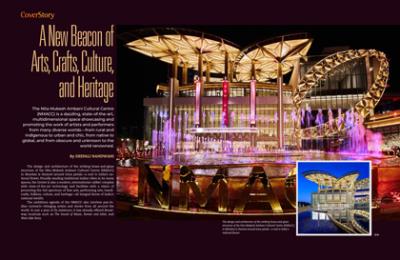
The Nita Mukesh Ambani Cultural Centre (NMACC) is a dazzling, state-of-the-art, multidimensional space showcasing and promoting the work of artists and performers from many diverse worlds—from rural and indigenous to urban and chic, from native to global, and from obscure and unknown to the world renowned.
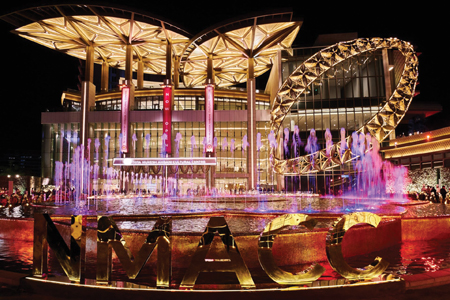
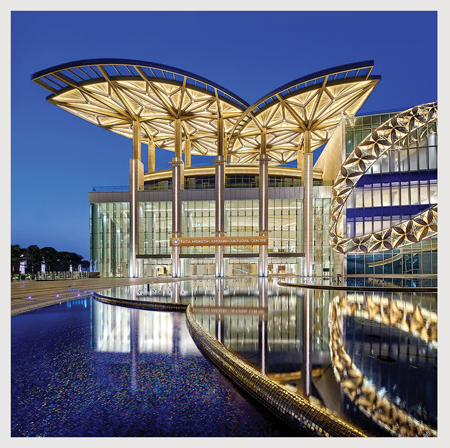 The design and architecture of the striking brass-and-glass structure of the Nita Mukesh Ambani Cultural Centre (NMACC) in Mumbai is themed around lotus petals—a nod to India's national flower.
The design and architecture of the striking brass-and-glass structure of the Nita Mukesh Ambani Cultural Centre (NMACC) in Mumbai is themed around lotus petals—a nod to India's national flower.
The design and architecture of the striking brass-and-glass structure of the Nita Mukesh Ambani Cultural Centre (NMACC) in Mumbai is themed around lotus petals—a nod to India’s national flower. Proudly exuding traditional Indian vibes in its many spaces, the Centre is also a modern, international-caliber complex with state-of-the-art technology and facilities with a vision of promoting the full spectrum of fine arts, performing arts, handicrafts, folklore, culture, and heritage—all integral facets of India's national wealth.
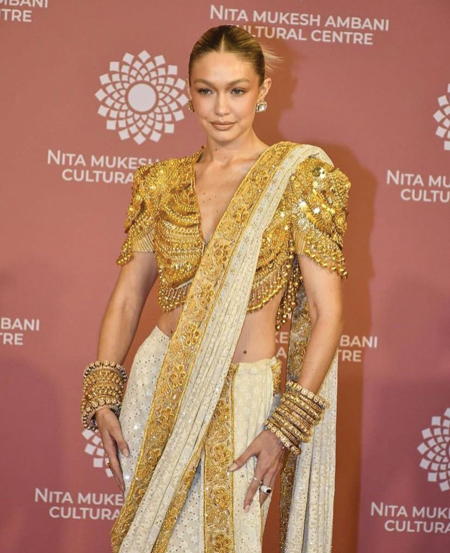
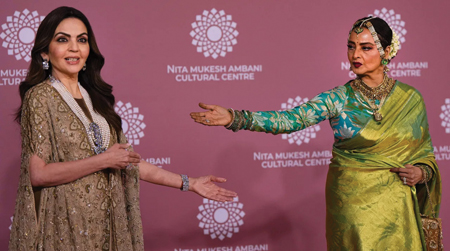
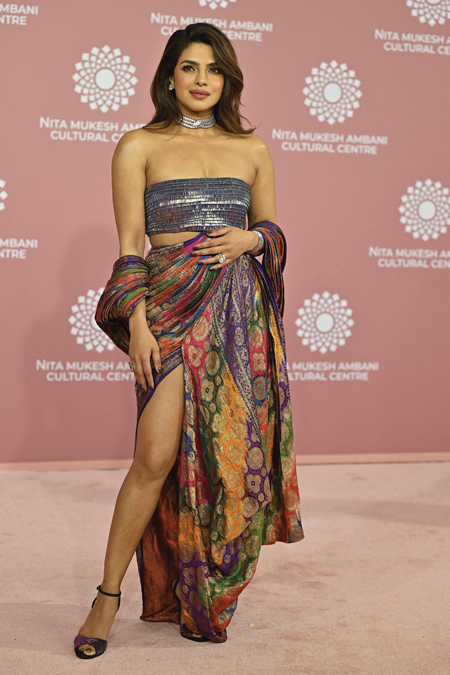
National and international celebrities at the inauguration of NMACC:
[Top left] American fashion model Gigi Hadid.
[Right] The evergreen Rekha with Nita Ambani.
[Bottom left] Priyanka Chopra.
The ambitious agenda of the NMACC also involves pan-Indian outreach—bringing artists and shows from all around the world. In just a year of its existence, it has already offered Broad-way musicals such as The Sound of Music, Romeo and Juliet, and West Side Story.
Sprawling across over 52,000 square feet, the NMACC houses three distinct performing art venues: the Grand Theatre (2,000 seats), the Studio Theatre (250 seats), and the Cube, an intimate, exclusive sp-ace with 125 seats. Then there is the four-storied, 16,000-square-foot Art House “designed to showcase a shifting array of installations and exhibits that bring the treasures of Ind an and global art to the audience.”
Right from its magnificent inauguration in March 2023, the Centre made a bold statement proclaiming its stature as India's next big thing in the realm of arts and culture. The impressive guest list included top honchos from the world of arts, entertainment, fashion, industry, and politics—national and international. Hollywood personalities such as Zendaya, dressed in an embellished Rahul Mishra sari; Gigi Hadid, in an Abu Jani Sandeep Khosla ensemble; Tom Holland; Penelope Cruz; Priyanka Chopra, along with her husband Nick Jonas; and just about the entire Indian entertainment industry pantheon, from Shah Rukh Khan to Karan Johar, turned out in their fashionable best.
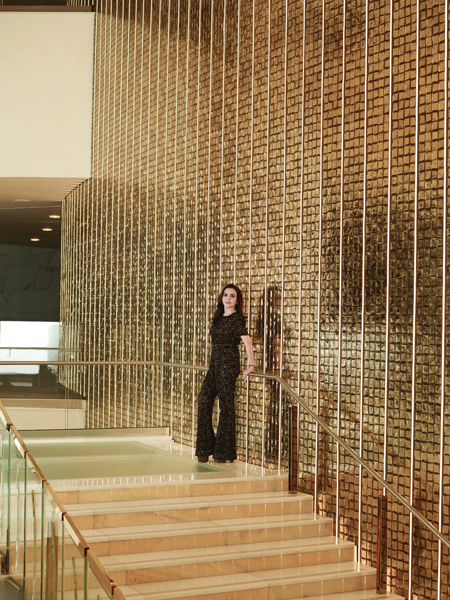
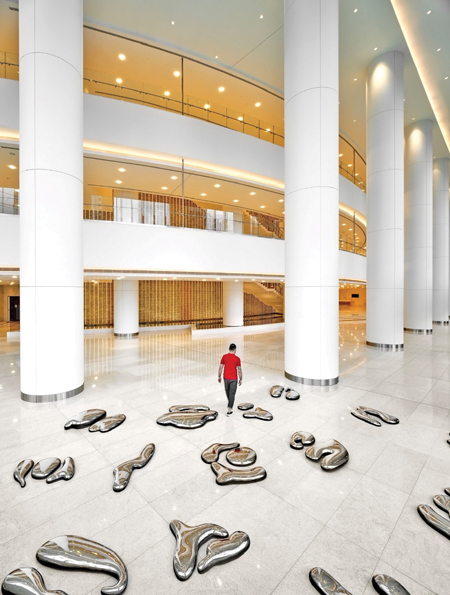
“Culture fosters mutual understanding, tolerance, and respect, weaving communities and countries together, and bringing hope and happiness to humanity,” says Nita Ambani, founder of the NMACC.
And yet, the real story of the NMACC is not just about glamor. Instead, it is about what it contributes to India’s cultural space. The country has not had anything as all-encompassing and as well-funded in this space. Nita Ambani, the driving force behind the NMACC, describes it as “our humble dedication to new India.”
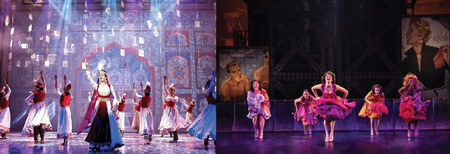
Grand classics at the Grand Theater: Mughal-e-Azam and West Side Story.
The classical dancer-turned-philanthropist and patron of the arts says, "For the last few years, my daughter Isha and I, along with our team, have immersed ourselves in this dream project. She added, “Culture fosters mutual understanding, tolerance, and respect, weaving communities and countries together, and bringing hope and happiness to humanity. As an artist, I aspire for this Centre to be a place that honors the arts, artists, and audience alike—a space where our people can take pride in their heritage.”
The influence of the NMACC extends far beyond the confines of Mumbai. Serving as a cultural hub, it places India prominently on the global cultural stage, akin to how Broadway represents the U.S., or the Louvre represents France.
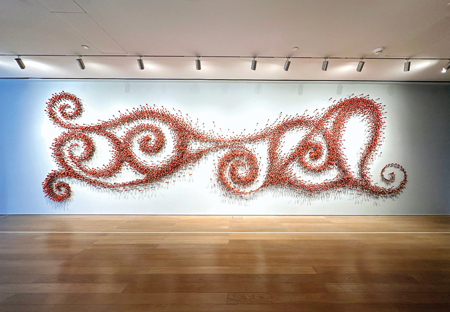
Grand spectacles!
Over the last year, the Centre’s Grand Theatre has brought to Indian shores Broadway musicals such as The Sound of Music, Lonny Price’s modern-day adaptation of Romeo and Juliet, and the Grammy- and Tony Award-winning West Side Story.
[Right] Sundew, a lacquered wood and pigments exhibit in the ‘Sangam/Confluence’ collection.
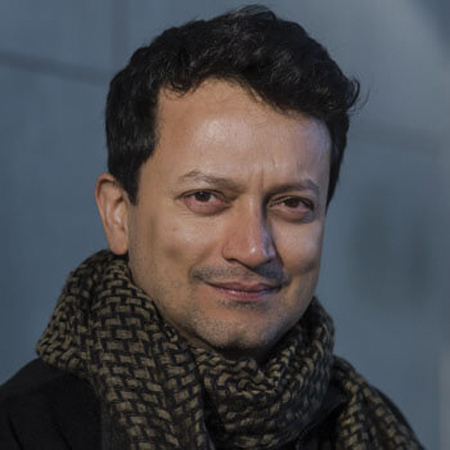
The ‘Sangam/Confluence’ exhibit was a collaboration of Jeffrey Deitch, a New York-based artist, curator, and art dealer, and Ranjit Hoskote, a poet, cultural theorist, and curator.
Among the big performances was also Feroz Abbas Khan's visionary spectacle, The Great Indian Musical: Civilization to Nation. Its narrative traced the history of performing arts in India, from the primordial sound of the universe—Om—to the nation's independence. Against a vividly cinematic 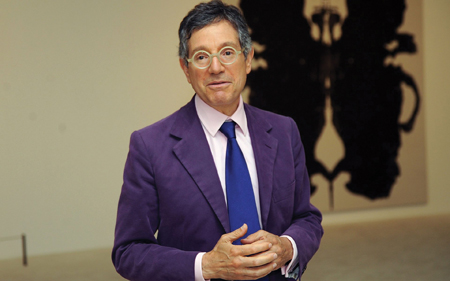 backdrop blending handcrafted sets with digital imagery, the production design of this spectacle unfolded through collaborations with Tony Award-winning lighting designer Donald Holder (known for his work on The Lion King), Obie Award-winning set designer Neil Patel (previously involved in Feroz Abbas Khan's Mughal-e-Azam), and Emmy-nominated projection designer John Narun.
backdrop blending handcrafted sets with digital imagery, the production design of this spectacle unfolded through collaborations with Tony Award-winning lighting designer Donald Holder (known for his work on The Lion King), Obie Award-winning set designer Neil Patel (previously involved in Feroz Abbas Khan's Mughal-e-Azam), and Emmy-nominated projection designer John Narun.
One of Khan’s earlier theater spectacles, Mughal-e-Azam, made a comeback in February. “Once, people used to journey to Broadway or the West End to experience spectacles," Khan reflects. Mughal-e-Azam stands as contemporary Indian theater's closest brush with a Broadway-level production. "Even if we possessed the talent and creativity, we lacked the infrastructure and financial backing necessary to realize such productions. The Grand Theatre at the Nita Mukesh Ambani Cultural Centre is a global venue that offers us the platform we need."
A confluence of cultures
For the expansive opening show called ‘Sangam/Confluence’ at the NMACC, Jeffrey Deitch, a New York-based artist, curator, and art dealer, collaborated with Ranjit Hoskote, an art curator and theorist. Deitch, present in Mumbai for the event, emphasized how numerous esteemed European and American artists have been profoundly influenced by their exploration of Indian art and philosophy. According to him, "One of the important objectives of ‘Sangam/Confluence’ was to further this Indian and international artistic dialogue."
‘India in Fashion,’ a spectacular show last year, explored India’s defining influence on global fashion, beginning in the 17th century and persisting to the present day. Hamish Bowles, the just-retired Vogue's global editor-at-large, who curated the exhibition, explored how India's rich sartorial and textile traditions have inspired imitation across centuries and continents, from the courts of Louis XVI to the couturiers of Jazz Age Paris, the sportswear designers of midcentury America, and the hippies of the Summer of Love.
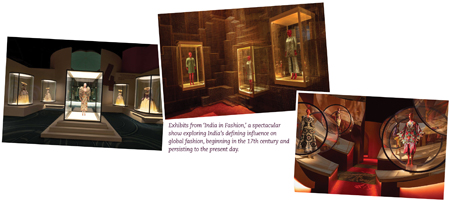
The odds of a film being accepted at the elite Sundance Film Festival are less than one percent! (Photo: Jen Fairchild)
Patrick Kinmonth, an Anglo-Irish opera director and designer, filmmaker, writer, painter, interior designer, art editor, creative director, and curator, designed ‘India in Fashion’ along with architect Rooshad Shroff. He says, “Art and culture needed a new patron of arts, which has the ability to draw in global talent. Across the world, resources are drying up for art and culture, so having such resources is exciting.”
What’s a creative space that does not indulge in the eclectic and the eccentric? ‘Run As Slow As You Can’ was an absurdist exhibit featuring the work of Italian artists Maurizio Cattelan and Pierpaolo Ferrari, founders of TOILETPAPER magazine. It displayed thought-provoking pieces resonating with India’s cultural pulse, and was an immersive exploration of creativity across four floors, pushing the boundaries of artistic expression.
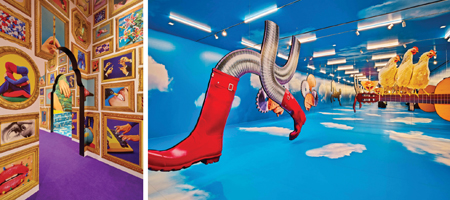
‘Scenes from Toiletpaper,’ an absurdist exhibit of the work of Italian artists Maurizio Cattelan and Pierpaolo Ferrari.
Many cities worldwide are making a growing effort to position themselves as the next major cultural hubs. "Culture is now a significant industry," remarks Deitch. "In past eras, economic prowess stemmed from steel plants and mining. Nowadays, we witness the influence of the cultural industry. Cities like Mumbai and Dubai are emerging as new cultural epicenters, prioritizing museums and music venues as avenues for economic power and cultural significance. However, when a city or country possesses a robust local cultural and artistic scene, as Mumbai and India do, the artistic process becomes inherently more authentic and sincere."
Lawrence Van Hagen, an American art curator and advisor, has spearheaded a recent monumental pop art project titled ‘Pop: Fame, Love, and Power’ at the Art House at the NMACC. The exhibit brings together 12 American pioneers of the Pop art movement, including Andy Warhol and Keith Haring. "Many of these artists have not yet been exhibited in India before, so it truly is an exciting time for both the cultural institutions in India and the public to experience international art in their home country," remarks Van Hagen.
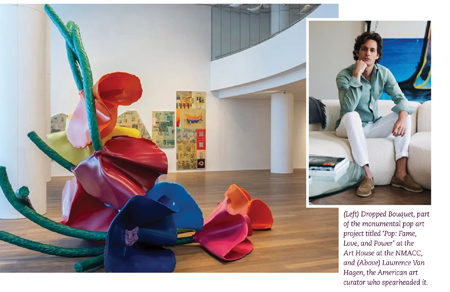
[Left] Dropped Bouquet, part of the monumental pop art project titled ‘Pop: Fame, Love, and Power’ at the Art House at the NMACC, and [Right] Lawrence Van Hagen, the American art curator who spearheaded it.
Democratizing culture
The NMACC is not just about the big budget productions that require a hefty entry price. There are performances by dancers and musicians, and shows by artists, which cost a fraction of that amount. In its expansive lobby are showcased India’s artisans and weavers who don’t often get such a platform.
As an incubator of talent, the Centre aims to identify and nurture emerging artists through outreach programs in collaboration with art institutions across India. With dedicated translation booths, cross-cultural collaborations, and multilingual programming, the center strives to bridge divides and foster a sense of unity through the universal language of art. A key focus is on regional programming, with the NMACC showcasing multilingual content for non-English speakers.
Nita Ambani says, “We envisioned the Centre as a haven not only for India's top talents from cities but also from small towns and remote villages. I hope to inspire and empower future generations. As long as we have the stage, we have a voice. And as long as we have a voice, we have the power to tell our stories—stories that shape our history.”
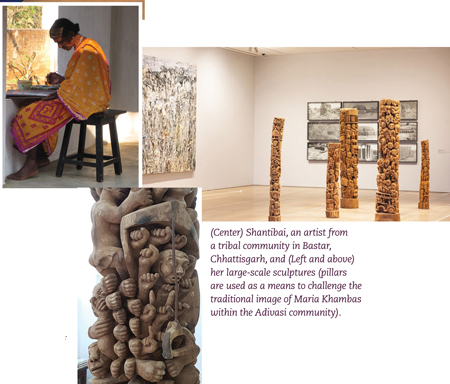
Featured among the artists showcased in the Art House’s inaugural exhibit, ‘Sangam/Confluence,’ is Shantibai, an artist hailing from a tribal community in Bastar, Chhattisgarh. Through her large-scale sculptures, she employs pillars as a means to challenge the traditional image of Maria Khambas—historically used to depict revered figures within the Adivasi community. Shantibai's wooden works convey narratives reflecting the contemporary struggles faced by her people, caught amidst the tensions of a militarized state and Maoist influences.
Many of these classical and folk art forms, particularly those associated with protest against the system, have never found their way to theaters in urban India till now, a lacuna that the NMACC hopes to bridge. The Centre has fostered a new era in Mumbai's cultural landscape. Danseuse Aditi Mangaldas believes that new venues breed fresh artistic expressions, musical compositions, and narratives. Says she, “India is in dire need of dedicated art spaces and a professional fund to support artists, both of which NMACC offers.”
Deepali Nandwani is a Mumbai-based freelance journalist, a columnist on luxury with CNBC-TV18, and an aficionado of everything heritage.
The Spaces of the NMACC
The Grand Theatre
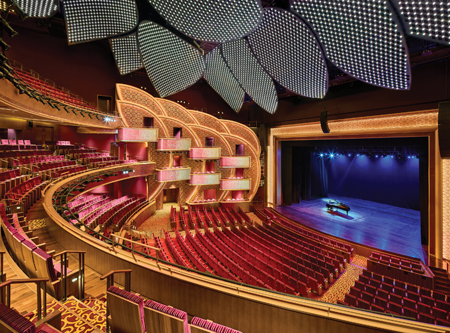 At the NMACC’s core is the Grand Theatre, a majestic space reminiscent of the grandeur of historical monuments, yet equipped with state-of-the-art technology and amenities fit for the 21st century.
At the NMACC’s core is the Grand Theatre, a majestic space reminiscent of the grandeur of historical monuments, yet equipped with state-of-the-art technology and amenities fit for the 21st century.
Designed by Steve Clem and Nick Wolfcale of TVS Design, in partnership with Brian Hall of Theatre Projects Consultants, it draws inspiration from the iconic Dolby Theatre in Hollywood. Boasting 2000 seats, each offering unobstructed views of the stage, the theater features a Dolby Atmos Surround Sound system, a 100-seat orchestra pit, a 69 batten fly system, and an LED light sculpture studded with 8,400 Swarovski crystals, programmable as part of any production's lighting design.
"Artists will no longer be constrained by their imaginations," says director Feroz Khan, whose larger-than-life theater productions have found a home here.
Imagine being enveloped by the rich acoustics of the Grand Theatre as an ensemble of performers transports you into the heart of a timeless classic like West Side Story or The Great Indian Musical: Civilization to Nation. The title of an article in Vogue magazine proclaims, “The Nita Mukesh Ambani Cultural Centre’s Grand Theatre Heralds a Golden Age for Indian Performing Arts.”
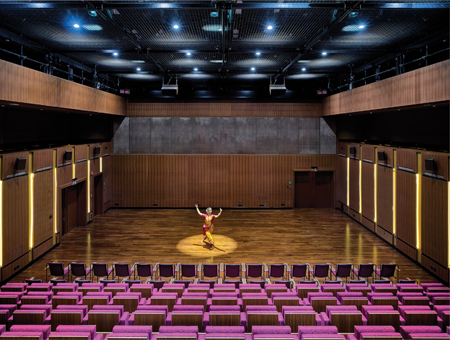
The Studio Theater
Designed for both emerging and established artists, the Studio Theatre is a 250-seat venue equipped with a telescopic seating system and advanced soundproofing technology. It serves as an ideal setting for a variety of events, ranging from intimate performances to community gatherings. Additionally, it boasts a pioneering tension wire grid, facilitating effortless management of lighting and rigging arrangements during production.
[Left] The Studio Theater.
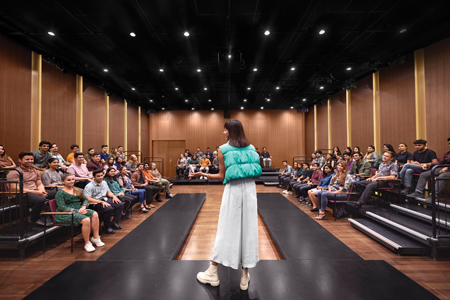
The Cube
The Cube serves as a specialized platform for nurturing emerging Indian artists across various disciplines, including new and experimental theater, spoken word, and music. With a flexible stage layout and seating capacity for 125 attendees, the space is equipped with cutting-edge technology such as a Panasonic laser projection system, an Assisted Listening system with infrared emitters, and a fully-integrated video recording and production setup.
[Right] The Cube.
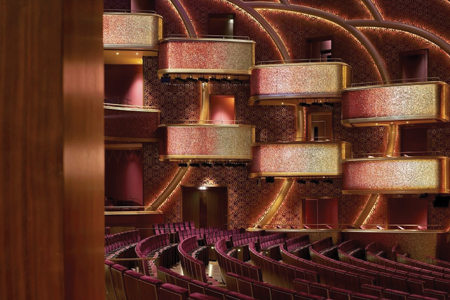 The Art House
The Art House
Step into the Art House, a four-story visual arts space overlooking the Fountain of Joy (a square dominated by a fountain), where public art exhibits and installations come to life, reflecting the diversity and vibrancy of India's artistic heritage.
Spanning four floors in the serene 16,000 square foot space, the works of 11 established and emerging contemporary Indian artists, along with those influenced by India, explored diverse interpretations of the nation and its traditions.
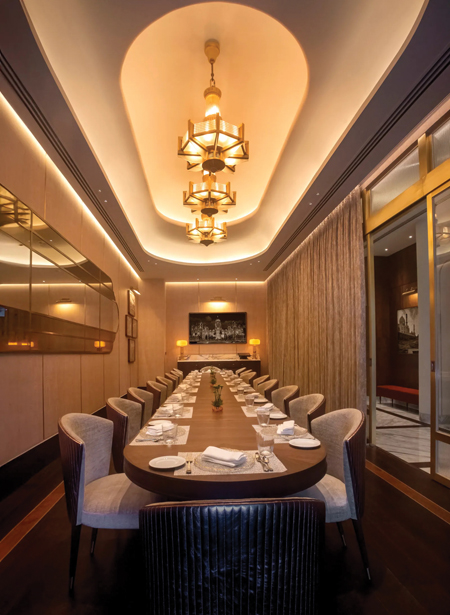 Fine Dining at Its Finest
Fine Dining at Its Finest
The NMACC is a culinary haven, as much as it is an art and cultural center. The Oberoi Group’s AMADEO by Oberoi is a Parisian-style café. But then, you walk through a corridor flanked by a fine wine collection into a spacious restaurant with a soaring ceiling, bathed in natural light. The restaurant is a showcase of the world’s best cooking techniques: wood-fired oven for pizzas, Otoro at the sushi station, Bao steamers, and such. AMADEO by Oberoi eschews the tried and tested: no butter chicken, no ramen, and no tempura. Instead, it focuses on the classics and the gourmet. The team has brought into play Counter Collection—cluster of micro-concepts of Japanese, Chinese, Japanese, Italian, and Indian cuisines.
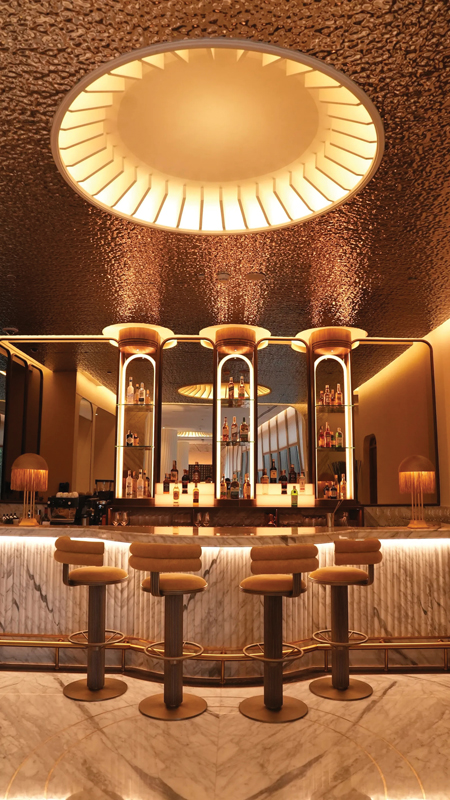
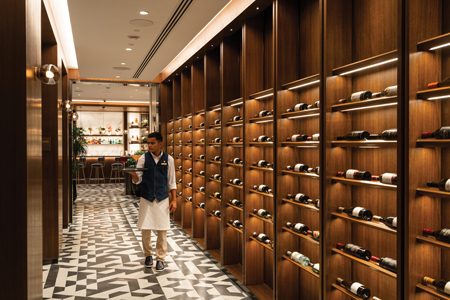 Indian Accent, one of India's most-awarded restaurants, opened its Mumbai iteration at the NMACC two months ago, after its brilliant run in the capital city. Mumbai’s heritage of the Art Deco period— also called the Jazz Age—comes alive in the decor, the music, and cocktails. The menu for Mumbai debuts Indian Accent favorites such as Gunpowder prawns, red rice, smoked chilli & raw mango curry, Guchhi matar, asparagus, Kashmiri morel pulao, Burrata chaat, lotus root papdi, and mustard tomato jam.
Indian Accent, one of India's most-awarded restaurants, opened its Mumbai iteration at the NMACC two months ago, after its brilliant run in the capital city. Mumbai’s heritage of the Art Deco period— also called the Jazz Age—comes alive in the decor, the music, and cocktails. The menu for Mumbai debuts Indian Accent favorites such as Gunpowder prawns, red rice, smoked chilli & raw mango curry, Guchhi matar, asparagus, Kashmiri morel pulao, Burrata chaat, lotus root papdi, and mustard tomato jam.
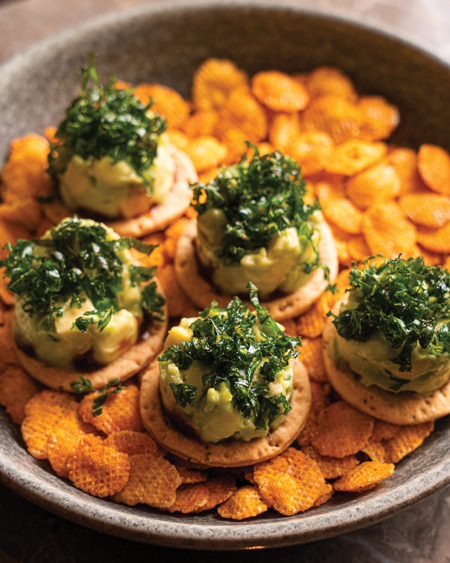
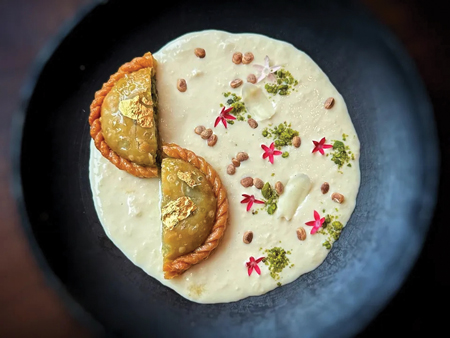
[Left] Kale and avocado chaat at
AMADEO by Oberoi.
[Right] Pistachio chandrakala, lachha rabri, and white
chocolate dessert at the Indian Accent.
Enjoyed reading Khabar magazine? Subscribe to Khabar and get a full digital copy of this Indian-American community magazine.
blog comments powered by Disqus












